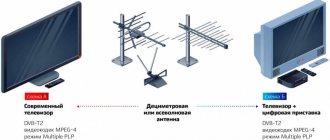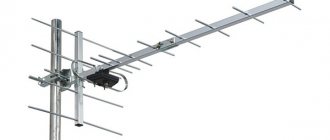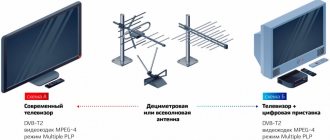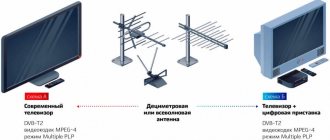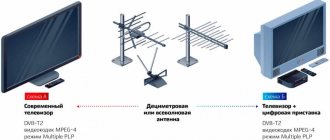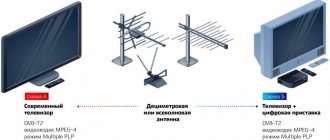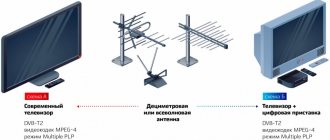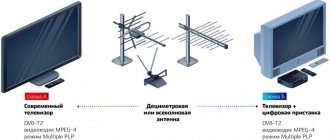Digital television has arrived in the villages of the Omsk region
On July 3, a solemn ceremony of launching the first digital television multiplex took place at the Omsk Regional Radio and Television Transmission Center. With the launch of the last, 48th station in Kalachinsk, digital TV in the region covered 99% of the population.
“Initially, to cover the entire territory of the Omsk region, the federal center planned to build 97 ground stations here. However, we managed to reduce their number to 48 with the same 99% coverage of the population. At the same time, 25 stations operating in the region had to be modernized and supplemented with modern equipment, another 23 stations were built from scratch, right up to the selection of a land plot. Today we will launch the last Kalachinskaya station. With its help, residents of Kalachinsky, part of Okoneshnikovsky, Nizhneomsky and Kormilovsky districts will be able to watch digital television. Investments in the construction of the network of the first multiplex amounted to more than 700 million rubles,” said Oleg Surikov, director of the regional broadcasting center.
According to data as of January 1, 2015, in the Omsk region, 97% of the region’s population could watch one television program in analogue mode, two programs - 93%, three - 83%. The maximum that was available to villagers was six channels. With the transition to digital, Omsk residents receive a package consisting of 10 channels and 3 radio programs.
Let us remind you that the first federal multiplex RTRS-1 includes: Channel One, channels Russia-1, Russia-2, NTV, Channel Five, Russia-K, Russia-24 and Carousel”, as well as radio stations “Vesti FM”, radio “Mayak” and “Radio Russia”.
“By launching the last station, we are not putting an end to it. And we are already building networks for the second multiplex. Already 12 stations in the region are ready to broadcast it. In addition, a coding center has already been prepared and put into operation, which will allow insertions of our local companies into the broadcasting of federal channels,” added Oleg Surikov.
During the launch ceremony, Olga Ilyutikova, head of the main department of information technology and communications of the Omsk region, noted:
“Omsk residents have once again proven that they can complete the assigned task efficiently and on time. This is a historical event. More than 80% of the region's residents watched only three channels; now they will have access to 10 channels and 3 radio programs. Now we have to work on launching the second multiplex.”
Please note that to watch digital TV, villagers need a modern digital TV or a special set-top box for receiving a digital signal in DVB-T2 format. This format is the second generation of the DVB-T standard, the European standard for terrestrial digital television. The capacity of its networks is 30% greater than that of DVB-T. The DVB-T2 format uses the MPEG-4 AVC video compression standard with OFDM modulation. Flow speed - up to 50 Mbit/s. The MPEG-4 standard includes DivX, XviD, H.264 codecs, high image quality is achieved thanks to the last of them.
“I thank the government of the Omsk region and Acting Governor Viktor Nazarov for their assistance and cooperation in the implementation of the federal target program. RTRS has been implementing the program since 2009; today a network has been built that provides coverage of 80% of the population of the Russian Federation, in 83 regions including Sevastopol and Crimea. A second multiplex is also being launched. It is already broadcast in 79 regions, reaching about 50% of the Russian population. Today the lines between city and countryside are blurring. The population can receive high quality programs. This is a breakthrough,” shared Deputy General Director of the Federal State Unitary Enterprise “Russian Television and Radio Broadcasting Network” (RTRS) - Director of the Department of Radio Broadcasting and Radio Communications Viktor Goreglyad.
According to a Moscow expert, today in Russia about 800 models of receivers and more than 140 models of set-top boxes are able to accept the DVB-T2 standard. Their cost is from 800 to 3,000 rubles.
Let us add that there are two multiplexes broadcasting in the city. Omsk residents watch 20 television channels in digital format. Ren-TV, Spas, STS, Domashny, TV-3, Sport Plus, Zvezda, Mir, TNT and Muz TV were added to the main channels.
News. Omsk
In Russia, more than 18 thousand settlements will remain without television in 2021.
At the beginning of 2021, analogue television will be switched off in Russia. Since the signal from the antenna will disappear in stages - it all depends on the region - a schedule has been drawn up for turning off analogue broadcasting.
It will be replaced by digital television. To receive such a TV signal, ordinary Russians are offered to buy special set-top boxes - and here the reformers proceed from the fact that everyone has a modern TV, by default. The catch is that even if you buy them, they won’t work everywhere.
For example, in the Omsk region there are about 20 villages where the “digital” will not work: these are Forpost (Bolsheukovsky), Larionovka (Znamensky), Blagoveshchenka (Isilkulsky), Komsomolsky (Isilkulsky), Severny (Isilkulsky), Orlovo (Krutinsky), Motorovo (Krutinsky), Nikolsk (Krutinsky), Karbyza (Muromtsevsky), Mikhailovka (Muromtsevsky), Guzenevo (Muromtsevsky), Yudinka (Muromtsevsky), Gromoglasovo (Odessa), Golubovka (Russko-Polyansky), Kalinino (Russko-Polyansky), Bessarabka (Russko-Polyansky), Galitsino (Sargatsky), Ploskoye (Sargatsky), Bakino (Sedelnikovsky), Knyazevka (Tarsky), Pikhtovoye (Tarsky), Troitsk (Tyukalinsky), writes “SuperOmsk”.
In total, there are more than 18 thousand settlements on the territory of Russia that are not covered by digital terrestrial broadcasting.
As BK55 commented in the regional GUIP, the region fully launched the second multiplex at the end of 2018. 20 digital channels became available to 99.8% of residents of the Omsk region. Before this, 67% of televisions in the region could receive no more than five TV channels. During the transition to digital, only a small part of the region's territory fell into the zone of uncertain reception of the digital signal. We are talking about 20 named settlements.
But at the same time, their residents will be able to take advantage of the program of the Federal Ministry of Communications of the Russian Federation and, on preferential terms, purchase satellite equipment with constant free access to 20 channels included in the 1st and 2nd multiplexes.
“The corresponding agreement has been reached with major satellite operators. Residents of these settlements were informed by RTRS about the preferential program; together with the heads of the settlements, door-to-door visits were carried out to clarify the lists of residents who require a satellite broadcast connection. No one will be left without television in the Omsk region,” the department noted.
From November 21, TV viewers in the Ust-Ishim, Tevriz, Bolsheukovsky and Znamensky districts will be able to watch 20 digital TV channels.
— The activation of multiplex 2 equipment will be carried out gradually. Residents of the northern regions will be the first to see the additional 10 television programs in digital quality, and the broadcasting area will gradually expand to the south,” said Oleg Surikov, director of the Omsk Regional Radio and Television Transmission Center.
— In December, programs from 2 multiplexes will be available to all residents of the region.
In the Omsk region, 25 repeaters transmitting analogue TV signals were modernized to broadcast a digital television signal, and an additional 23 repeaters were built.
As a result, digital television broadcasting in the region today covers 99.8% of residents.
30.11.2018
This week, 20 digital TV channels became available to television viewers in the Tarsky, Sedelnikovsky, Bolsherechensky, Muromtsevo, Sargatsky, Gorky and Nizhneomsky districts.
05.12.2018
The Omsk branch of the Russian Television and Radio Broadcasting Network began broadcasting programs from 2 multiplexes in Omsk, Novovarshavsky, Nizhneomsky, Russko-Polyansky, Pavlogradsky, Kormilovsky, Kalachinsky and Cherlaksky districts.
20 digital TV channels became available to another 200 thousand residents of the region.
12.12.2018
Today, the Omsk branch of the Russian Television and Radio Broadcasting Network began broadcasting television programs from 2 multiplexes in the Isilkulsky, Krutinsky, Moskalensky, Nazyvaevsky, and Tyukalinsky districts.
20 digital TV channels became available to more than 110 thousand residents of the region.
27.12.2018
Specialists from the Omsk radio and television center RTRS turned on the latest transmitters of the 2nd multiplex.
The digital television network is fully operational. Now 20 digital channels are available to no less than 99.8% of residents of the Omsk region.
Since 2013, RTRS has built 23 new broadcasting facilities in the region and reconstructed 25 existing ones. Before the advent of digital, almost 67% of residents of the Omsk region could receive no more than 5 TV channels.
We remind you: Low-income residents of the Omsk region are compensated for the costs of broadcast or satellite equipment .
The shutdown broadcasting in the Omsk region will begin on June 3, 2021.
3/5 — (2 votes)
Also read:
- Launches of digital terrestrial television broadcasting in Omsk
- Second multiplex in Omsk
- Low-income residents of the Omsk region will be compensated for the costs of broadcast or satellite equipment
You can ask questions about digital television on the DVBpro forum
Author: Alexander Vorobyov, Nov 28, 2021 | Permanent link to the page:
In 2021, Omsk residents will be left without their usual television
Starting next year, television broadcasting in the Omsk region will undergo dramatic changes. The fact is that starting from 2021, our region will gradually move away from analog television, replacing the somewhat outdated broadcast model with digital one. Today, November 13, the city held a briefing with the participation of experts, where they told what residents should be prepared for and what to expect.
According to Oleg Surikov, director of RTRS Omsk ORTPU, digital television will usher in a new era of better picture quality for Omsk residents. “While the signal travels from the television center to the consumer during analogue broadcasting, there is interference on the air, for example, if an airplane flies by or a trolleybus passes by. This is a minus of analog TV, while “digital” is built in such a way that all interference is neutralized. This is a big project for our country, the first multiplex of ten TV channels was launched back in 2015, by the end of this year we will launch another multiplex of ten TV channels ,” said Surikov.
Omsk residents should not be afraid of innovations; they will not affect those who use cable and satellite television. And those who have a regular antenna (analog television) should pay attention to their TV. If it was released before 2012, it is better to purchase a special digital set-top box (its cost in stores is from 600 to 6,000 rubles). Or buy a new TV.
Help: In more detail, those TVs that were released after 2012 are capable of receiving a digital signal. This possibility is indicated in the technical data sheet of the device with the DVBT2 sign. It is likely that the TV can receive a digital signal without any additional gadgets. Otherwise, you will have to equip the device with a special attachment. However, viewers will still benefit because the picture quality in digital television is much higher than the picture quality in analogue.
It is worth noting that there will be no shortage of special set-top boxes for the transition to digital television in Omsk, as well as an increase in their cost.
“The Ministry of Economy monitors the cost level of such set-top boxes. Even if the need to purchase devices increases, the price will remain the same and will not hit residents’ pockets,” said Anastasia Gulivatenko, head of the Main Directorate of Information Policy of the Omsk Region.
Help: Another way to find out what broadcast format your TV supports is to pay attention to the logo. If the letter “A” appears next to it, then the viewer is watching analogue broadcasting and to switch to digital he will need to purchase a digital set-top box.
But even if your TV is an older model and was released before 2012, then after the new year in Omsk it will most likely work, because local TV channels have already concluded an extension agreement to extend analogue broadcasting for 2021. Only the Culture channel can disappear
As Vladimir Kunitsa, technical director of the TV Signal service, previously reported to the Va-Bank newspaper, from January 1 the state will no longer subsidize analogue television, but regional authorities and the TV channels themselves can do this.
Vladimir Kunitsa:
— Our Television Center has already stated that an agreement has already been concluded with everyone except the “Culture” channel for the next year, which means they will broadcast in Omsk as before, i.e. nothing will change for Omsk residents in 2021. Digital television now runs in parallel with analogue. There are antennas for its reception in almost all homes. Note that you have to pay for their service, but the 20 digital channels themselves are free. But only new modern TVs can receive them. For the rest, except for the antenna, you need special attachments.
| Omsk residents can watch these channels in digital quality right now |
But let us remind you once again that either modern televisions or digital set-top boxes can receive a digital signal. As Oleg Surikov promised, every Omsk resident will be able to receive a free guide to setting up equipment. The instructions are written in simple language, with a bit of humor and are accompanied by pictures and diagrams.
Two telephone numbers where you can call for advice and ask questions about setting up set-top boxes:
- 8–962–058–44–84,
- 8–800–220–020–02.
Let us add that the largest federal channels, for example First or Rossiya 1, will not rush to turn off analogue TV in large cities.
But in rural areas it is planned to start turning it off in January 2021. Photo: Christina Abrahamyan, cbsnews.com, pixabay.com, formulaforprosperity.com
What you need to know about the transition to digital
What is needed to watch TV without problems when switching to digital is a question that concerns most residents of the Omsk region. Specialists from the Russian Television and Radio Broadcasting Network explain why, when, how and how much it costs for everyone.
Signal without interference
The television signal enters our apartments and houses in three ways: through cable networks, including through Internet providers, satellite channels and through regular television antennas. More than half of the region's residents already receive TV channels in the digital standard. The digital signal always broadcasts without interference. The image on the screen is almost perfect, the signal is not afraid of interference on the air, and allows you to connect various additional services for viewers: for example, teletext, voting during the broadcast. If analogue television operates on the principle of “one channel occupies one frequency,” then with digital broadcasting, a whole package of channels can be simultaneously transmitted over one frequency – a multiplex.
Thanks to the state program for the transition to digital terrestrial television, even in the most remote areas of the region, viewers will be able to receive twenty TV channels in digital quality. The first multiplex (package of federal television programs with 10 channels) includes: Channel One, Russia-1, Russia - Culture, Russia-24, NTV, St. Petersburg - Channel 5, TVC, Match!, Carousel, OTR. The second multiplex includes: STS, TNT, RenTV, Pyatnitsa, Spas, Domashny, Zvezda, TV3, Mir, Muz TV, as well as three radio channels: Radio Russia, Mayak and Vesti FM. All this is available absolutely free of charge; no subscription fee is required to receive two multiplexes.
A powerful digital TV infrastructure with almost one hundred percent coverage of the territory has been created in the Omsk region
The main thing is the attachment
To receive digital, the TV must support the DVB-T2 format. In our country, since 2012, there has been a decree prohibiting the production and import into Russia of televisions that do not read this format. Read the instructions, it should indicate whether your TV can receive a digital signal. Owners of TVs produced before 2014 will need a special set-top box, which costs from 600 to 1,500 thousand rubles. The logos of analogue broadcasting TV channels are now supplemented with a special letter A. If you see this letter on the screen, it means it’s time to take care of purchasing a set-top box or reconfiguring the equipment. The average cost of such a set-top box is from 500 to 900 rubles. The regional government has created a working group that monitors retail chains. The consoles have been purchased, and entrepreneurs assure that even with a significant increase in demand for this equipment, which is inevitable, prices will remain the same.
With set-top boxes (they are called decoders or tuners), questions are already arising - there are many sellers who sell unsuitable products, for which you then have to buy additional spare parts. You will need a device that supports the DVB-T2 standard. Please note: there are still tuners on sale only for the earlier generation of standards - DVB-T. It will also support digital television, but it is better to buy a device with a reserve; technology does not stand still. All the main technical characteristics of DVB-T2 set-top boxes (received frequency range, modulation types, formats of decoded audio/video signals, etc.) are described in detail in the manufacturer’s instructions, and there is no point in listing them. But the device must be able to: automatically determine DVB-T2 parameters; provide signal reception in multi-PLP (multi-stream) mode; reproduce images in 4:3 and 16:9 aspect ratios; have a brightness resolution (horizontal and vertical): 720 x 576, 1280 x 720, 1920 x 1080; have sufficient sensitivity of the receiving path (the better this indicator, the greater the distance from the repeater the device can receive the signal and provide a high-quality video image).
The tuner can be connected to the TV in two ways: via an RCA cable (the so-called “tulip” of three multi-colored connectors) and via an HDMI cable. Therefore, the selected tuner must have at least one of these connectors. Modern, even the cheapest, models usually have both. Please note that older analog TVs may only have an input for a SCART connector (it is difficult to confuse it with something: it is oblong with 20 pins). In this case, you will need a SCART-RCA or SCART-HDMI adapter. Modern tuners have a USB connector. You will need it if you want to connect a flash drive or hard drive and, for example, watch a movie - the tuner essentially becomes a multimedia set-top box. In this case, pay attention to whether the set-top box supports DolbyDigital sound. If not, some movies will play without sound. Also pay special attention to the remote control of the set-top box. It should be comfortable for you. Keep in mind that in the future you will only change channels using this remote control. And the usual one from the TV will only be used to turn it on/off.
You will also need a UHF antenna. If you watched TV before switching to digital, you most likely already have such an antenna - either personal or shared (if you live in an apartment building). If the antenna is old, meter range, then it also needs to be changed to decimeter. It can be either indoor or outdoor, depending on your distance from the TV tower.
Low-income Omsk residents, as the regional government promises, will be able to receive state social assistance for the purchase of equipment for receiving digital television. To receive social assistance, citizens whose income is below the subsistence level must contact the comprehensive social service centers at their place of residence or place of stay with an application. You must have with you a passport, a certificate of state registration of marriage, a birth certificate or other documents confirming family composition, a copy of the work record book of the citizen and each member of his family, documents containing information about income for the last 3 calendar months, and bank account details.
What awaits Omsk residents
Analogue broadcasting of mandatory public television and radio channels in the Omsk region will be switched off on June 3, 2021. The Omsk region, together with 56 other regions, will enter the third stage of the transition to digital broadcasting. After the broadcast of analogue television programs is turned off, a message will be posted on their frequencies about the need to switch to digital television reception. The screensaver will be broadcast within a week. Regional TV channels and TV channels that are not part of multiplexes will continue analogue broadcasting. Cable and satellite television subscribers are already receiving signals in digital quality. Nothing will change for them, as, for example, for Obkom TV subscribers. The branches of RTRS “Omsk ORTPTS” and State Television and Radio Broadcasting Company “Irtysh” have already begun broadcasting regional programs as part of the package of digital TV channels RTRS-1 in the Omsk region. “Channel 12” will continue to broadcast in the analogue standard – the State Commission on Radio Frequencies (SCRF) has extended this opportunity for regional TV channels until August 2020. By this time, the issue of broadcasting them in digital format or continuing broadcasting in analogue will be decided. For broadcasting regional channels in digital format, the possibility of creating special inserts on the air of Public Television is being considered. This channel is one of 20 all-Russian public channels; each subject will be able to choose one of their regional channels, which will broadcast in the “Public Television” broadcast for 3-4 hours, and the rest of the time the channel will broadcast the content of the federal channel.
For all questions about the transition to digital television, you can contact the hotline of the Russian Television and Radio Broadcasting Network: 8-800-220-20-02.
Natalya Yakovleva.
